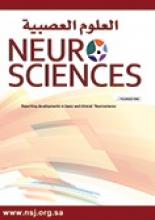Research ArticleOriginal Article
Open Access
Postural sway changes during static standing with concurrent task in children with traumatic brain injury
Rabiatul A. Abdul Rahman, Fazah A. Hanapiah, Azlina W. Nikmat, Nor A. Ismail and Haidzir Manaf
Neurosciences Journal January 2019, 24 (1) 29-35; DOI: https://doi.org/10.17712/nsj.2019.1.20180195
Rabiatul A. Abdul Rahman
From the Centre of Physiotherapy (Abdul Rahman, Manaf); from the Clinical and Rehabilitation Exercise Research Group (Hanapiah, Manaf), Faculty of Health Sciences; from the Department of Rehabilitation Medicine (Hanapiah), from the Department of Psychiatry (Nikmat), Faculty of Medicine, Universiti Teknologi MARA, and from the Department of Rehabilitation Medicine (Ismail), Hospital Sungai Buloh, Jalan Hospital, Selangor, Malaysia
MScFazah A. Hanapiah
From the Centre of Physiotherapy (Abdul Rahman, Manaf); from the Clinical and Rehabilitation Exercise Research Group (Hanapiah, Manaf), Faculty of Health Sciences; from the Department of Rehabilitation Medicine (Hanapiah), from the Department of Psychiatry (Nikmat), Faculty of Medicine, Universiti Teknologi MARA, and from the Department of Rehabilitation Medicine (Ismail), Hospital Sungai Buloh, Jalan Hospital, Selangor, Malaysia
MDAzlina W. Nikmat
From the Centre of Physiotherapy (Abdul Rahman, Manaf); from the Clinical and Rehabilitation Exercise Research Group (Hanapiah, Manaf), Faculty of Health Sciences; from the Department of Rehabilitation Medicine (Hanapiah), from the Department of Psychiatry (Nikmat), Faculty of Medicine, Universiti Teknologi MARA, and from the Department of Rehabilitation Medicine (Ismail), Hospital Sungai Buloh, Jalan Hospital, Selangor, Malaysia
PhDNor A. Ismail
From the Centre of Physiotherapy (Abdul Rahman, Manaf); from the Clinical and Rehabilitation Exercise Research Group (Hanapiah, Manaf), Faculty of Health Sciences; from the Department of Rehabilitation Medicine (Hanapiah), from the Department of Psychiatry (Nikmat), Faculty of Medicine, Universiti Teknologi MARA, and from the Department of Rehabilitation Medicine (Ismail), Hospital Sungai Buloh, Jalan Hospital, Selangor, Malaysia
MDHaidzir Manaf
From the Centre of Physiotherapy (Abdul Rahman, Manaf); from the Clinical and Rehabilitation Exercise Research Group (Hanapiah, Manaf), Faculty of Health Sciences; from the Department of Rehabilitation Medicine (Hanapiah), from the Department of Psychiatry (Nikmat), Faculty of Medicine, Universiti Teknologi MARA, and from the Department of Rehabilitation Medicine (Ismail), Hospital Sungai Buloh, Jalan Hospital, Selangor, Malaysia
PhD
References
- ↵
- Langlois JA,
- Sattin RW
- ↵
- Dewan MC,
- Mummareddy N,
- Wellons JC 3rd.,
- Bonfield CM
- ↵
- Agostini V,
- Chiaramello E,
- Bredariol C,
- Cavallini C,
- Knaflitz M
- ↵
- Backeljauw B,
- Kurowski BG
- ↵
- Gagnon I,
- Swaine B,
- Friedman D,
- Forget R
- ↵
- Teasdale N,
- Simoneau M
- ↵
- Anderson V,
- Catroppa C
- ↵
- Anderson V,
- Eren S,
- Dob R,
- Le Brocque R,
- Iselin G,
- Davern TJ,
- et al.
- ↵
- Pashler H
- ↵
- Fabri TL,
- Wilson KE,
- Holland N,
- Hickling A,
- Murphy J,
- Fait P,
- et al.
- ↵
- Poreh A,
- Miller A,
- Dines P,
- Levin J
- ↵
- Sánchez-Cubillo I,
- Periáñez JA,
- Adrover-Roig D,
- Rodríguez-Sánchez JM,
- Ríos-Lago M,
- Tirapu J,
- et al.
- ↵
- Llorente AM,
- Voigt RG,
- Williams J,
- Frailey JK,
- Satz P,
- D'Elia LF
- ↵
- Llorente AM,
- Sines MC,
- Rozelle JC,
- Turcich MR,
- Casatta A
- ↵
- Franjoine MR,
- Gunther JS,
- Taylor MJ
- ↵
- Mancini M,
- King L,
- Salarian A,
- Holmstrom L,
- McNames J,
- Horak FB
- ↵
- Cherng RJ,
- Liang LY,
- Hwang IS,
- Chen JY
- ↵
- Cherng RJ,
- Liang LY,
- Chen YJ,
- Chen JY
- ↵
- McCulloch KL,
- Buxton E,
- Hackney J,
- Lowers S
- ↵
- Yogev-Seligmann G,
- Hausdorff JM,
- Giladi N
- ↵
- Blanchard Y,
- Carey S,
- Coffey J,
- Cohen A,
- Harris T,
- Michlik S,
- et al.
- ↵
- Pellecchia GL
- ↵
- Richer N,
- Saunders D,
- Polskaia N,
- Lajoie Y
- ↵
- Polskaia N,
- Lajoie Y
- ↵
- Pellecchia GL
In this issue
Postural sway changes during static standing with concurrent task in children with traumatic brain injury
Rabiatul A. Abdul Rahman, Fazah A. Hanapiah, Azlina W. Nikmat, Nor A. Ismail, Haidzir Manaf
Neurosciences Journal Jan 2019, 24 (1) 29-35; DOI: 10.17712/nsj.2019.1.20180195
Jump to section
Related Articles
- No related articles found.
Cited By...
- No citing articles found.





